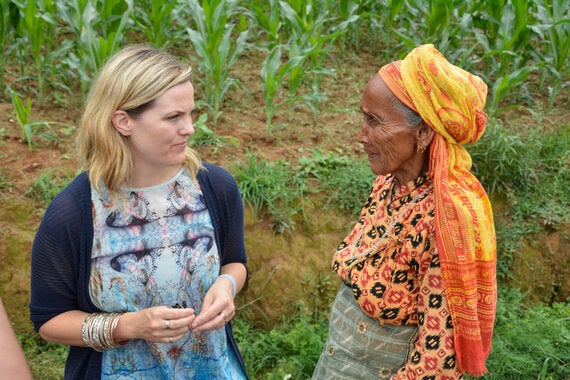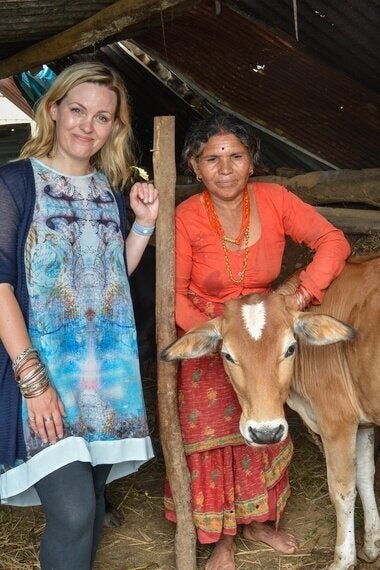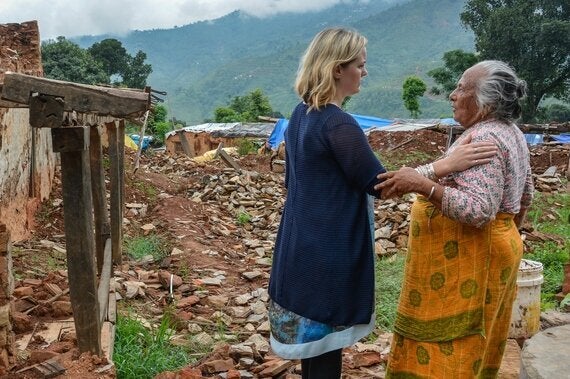In the first of two blog posts, Jo Joyner writes about her trip to Nepal where she met communities severely affected by the recent earthquakes.
The earthquake that hit Nepal on 25 April killed almost 9,000 people, brought over 600,000 houses tumbling to the ground and tore apart the lives of millions. Before travelling to Nepal with the charity CAFOD, I had very little knowledge of the country - and I wasn't sure what to expect.
Kathmandu - where we were staying - is a busy city. Traffic weaves between the locals who are completely unfazed. A lot of crazy wires and power cables that I'm glad I don't have to make sense of are used by monkeys as a highway. In the new part of town the destruction from the earthquake is not immediately evident. But in the old town, many of the ancient temples that survived the last major earthquake in the 1930s have been destroyed.

Jo Joyner surveys earthquake damage in Durbar Square, Kathmandu. CAFOD/Bikash Khadge
The day after we arrived, we travelled east out of Kathmandu for around three hours into the Kavrepalanchok region. As we drove into the mountains, the roads became more bumpy, neglected and precarious. As a control freak and a back seat driver, overtaking buses or cows on the hairpin corners was well out of my comfort zone!
During our journey we had to stop briefly as people cleared a landslide. The earthquake had dislodged soil and rocks from the mountain, and I could see how these mud roads would quickly become impassable during the fast-approaching monsoon season. The team from CAFOD's local partner Caritas Nepal told me that once the monsoon hits, there can sometimes be torrential rain for 10 days solid.
We were heading for the village of Chandanimandan to see how the earthquake had impacted remote communities, and to support Caritas Nepal handing out packs of corrugated iron to help people build shelters before the monsoon. When we arrived, the villagers were waiting for us peacefully, but as I looked at what remained of their houses I worried about the huge task they had ahead of them and wondered where they would begin.
I met Mishri, aged 74, small, slim and dressed traditionally. Despite all that she had been through she had a twinkle in her eye. She told me about the day that "the earth moved" when she was inside her house and it collapsed around her.

Jo Joyner meets Mishri Nepal, 74, whose house collapsed around her during the first earthquake. CAFOD/Bikash Khadge
She said she didn't remember how she managed to crawl out from under the rubble and lie outside. "I felt as if my soul had left me," she said. "I just stayed there, I didn't move and I waited for the earth to stop shaking."
She told me that she had thought that the Gods must be angry with them, but when Caritas Nepal arrived with help she felt that they must have been forgiven. She'd had no idea that people would come looking for them.
Next I met Rama, 53, a lady with a smile as bright as her traditional red sari. She was working in the fields when the earthquake hit. When the earth started to rumble beneath her feet she ran home with the ground still shaking. She checked on her two grown children and three grandchildren, thankfully all safe, but she lost two cows and five goats.

Jo Joyner with Rama Nepal, 53, who saved her calf from the rubble after digging frantically for three days. CAFOD/Bikash Khadge
The loss of animals is hugely significant to farmers like Rama and her husband. Not only do they provide an income and milk, but they are also an important part of spiritual life in the community. After the earthquake, Rama spent three days digging through the rubble to rescue one of her few remaining calves.
Finally I met Luma, an 83-year-old woman with an incredible face whose lines told a million stories. In her case, the devastation was clear to see. Luma's five sons had all built their homes alongside that of their mother and nothing remained of any of the buildings.
I got a strong sense that Luma had done everything right in her life and had tried so hard to make a stable future for her family. She told me she had saved for years to supplement her pension. She had kept her gold ring and gold necklace so that she would have some money should the worst ever happen. The worst had happened and it shattered around her modest possessions. Three months on and they're buried, deep amongst the rubble with little hope of ever being found.

Jo Joyner meets Luma Kumari Nepal, 83, whose life savings - money and jewellery - were inside her home when it collapsed. CAFOD/Bikash Khadge
The brave women I met were in a dire situation. They needed to salvage as much brick, rubble and corrugated sheeting as possible in order to rebuild their homes - and to search for their valuable possessions before the monsoon rain washed them away. This salvaging and rebuilding all takes time and energy that they don't have. They are living a hand-to-mouth existence; if they don't work the land they have no money and no food - and they also have to cook, tend the animals, clean clothes and care for the children.
CAFOD and Caritas Nepal began delivering aid within hours of the first earthquake striking. Some of the Caritas aid workers I met had lost their own houses in the earthquakes. While their own families live in tents, they carry on delivering food and shelter to some of the most hard to reach areas. If the roads become blocked, they unload and carry the supplies, trekking through the mud for hours to reach those most in need. I was humbled to be among them as they carried out their work.
Over the past three months, they have provided life-saving food, water, and shelter to nearly 300,000 people. But with the monsoon worsening, and with so many people like Mishri, Rama and Luma left with virtually nothing, it is a race against time to reach all those in need.
To donate to CAFOD's Nepal Earthquake Appeal, visit: cafod.org.uk/Nepal or call 0500 85 88 85